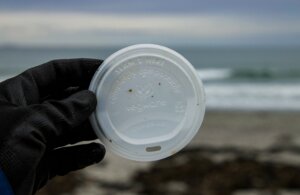‘Underwater Landscape’ by Arsenio Rodriguez at Rossana Orlandi Gallery (Credit: Simone Furiosi)
According to an article on Elledecoration.co.uk over the past decade, the phrase ‘sustainable design’ has become an increasingly familiar refrain in our lives. To begin with, it just seemed like a really good idea; something we should all be supporting in whatever ways we can. But now the conversation is becoming urgent. The recently released Global Assessment report by respected UN research body IPBES (Intergovernmental Science-Policy Platform on Biodiversity and Ecosystem Services), which combines the findings of nearly 15,000 international studies, reveals that time is running out to save the plants, animals and insects that support human life on Earth. Unless we change our lifestyles (and quickly), some unpleasant shocks lie ahead.
This challenge was one of the main focuses at April’s Milan Design Week. Its prominence in the minds of designers served as an admission that the resources the industry consumes represent part of the problem. Gallerist Rossana Orlandi focused the spotlight on plastics, one of the most controversial materials of all – according to the Royal Statistical Society, only around nine per cent of the plastic ever produced has been recycled. As part of her ‘Guiltless Plastic’ initiative, Orlandi showcased up-and-coming names such as German designer Alexander Schul, who repurposes polystyrene to make furniture, and Spaniard Alvaro Catalán de Ocón, whose lighting is made from plastic bottles. British duo Barber & Osgerby also addressed the limits of recycling by launching the ‘On and On’ chair for Emeco.
Unlike many plastic products, which can only be reused a few times – sometimes as little as once – the duo’s chair can be repurposed indefinitely. It’s made from rPET, a new material that combines plastic bottles with fibreglass, and whose strength means that new chairs can be made from old ones. ‘Sustainable design should go beyond materiality,’ says Edward Barber. ‘Thinking about the way products are manufactured, packaged and shipped also needs be part of the solution.’
The amount of plastic in our oceans, in particular, has been making headlines of late, and, at Orlandi’s exhibition, designer Brodie Neill highlighted the issue with his ‘Capsule’ hourglass. Filled with microplastic granules collected from Tasmanian beaches, the piece critiques our throwaway culture and serves as a tribute to the environmental workers who clean up our marine landscape.
‘Designers need to be looking beyond raw materials and using waste ones, as they are now, unfortunately, in abundance,’ says Neill. ‘Waste can be redeployed with endless circularity. We have to consider the impact of materials at every stage of their existence; the methodology should be cradle-to-cradle.’










